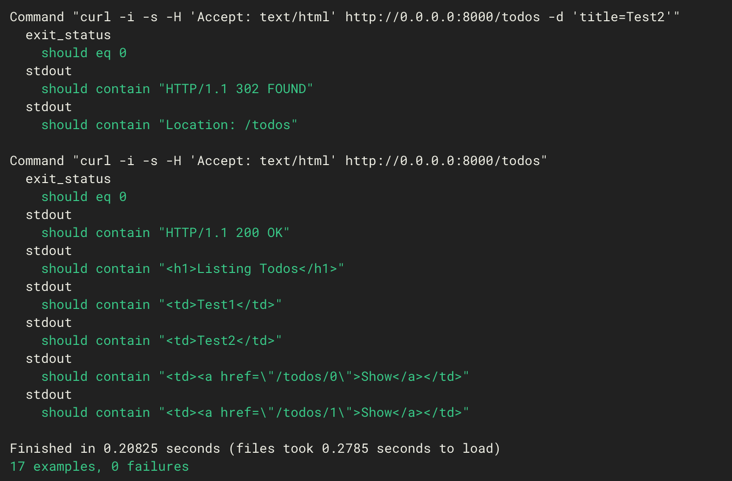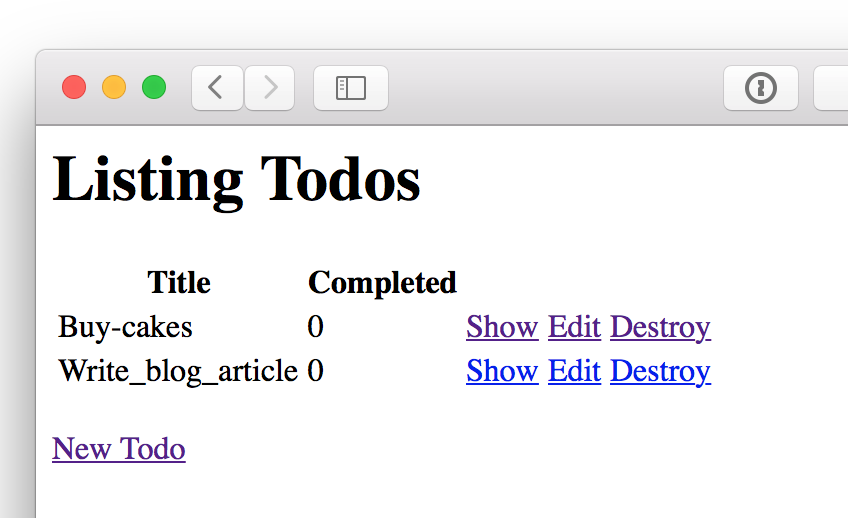Deploy Swift WebApps on Amazon EC2 Container Services (ECS)
TL;DR
Developing Web applications with Swift is pretty fun 🤘
We can run them on Amazon EC2 Container Services and I tried to build light-weight Docker image to deploy more faster.
Here is an example project I made, check this out :point_down:
- https://github.com/ngs/Swifton-TodoApp
- https://hub.docker.com/r/atsnngs/docker-swifton-example/
- https://circleci.com/gh/ngs/Swifton-TodoApp
Swift Web Frameworks
Since Swift language became open source, some web application frameworks come out.
Swifton
I’m not yet sure about which is the best. But I started trying Swifton the Ruby on Rails port of Swift Language.
The interface is pretty easy to understand:
import Swifton
import Curassow
class MyController: ApplicationController {
override init() {
super.init()
action("index") { request in
return self.render("Index")
// renders Index.html.stencil in Views directory
}
}
}
let router = Router()
router.get("/", MyController()["index"])
serve { router.respond($0) }
Swifton TodoApp
Swifton has an example Todo app project: necolt/Swifton-TodoApp
This already has a Dockerfile and Heroku configurations (app.json and Procfile).
This works, so we can get started with this. But I don’t want to use Heroku for production and tried to use Amazon EC2 Container Service (ECS) instead.
Fat Docker Image
As I mentioned above, this project has a Dockerfile and we can build an image to work with ECS.
But the image contains entire depending libraries to build Swift source code in itself. That becomes 326 MB image size and 893.2 MB virtual size.
REPOSITORY TAG IMAGE ID CREATED VIRTUAL SIZE
<none> <none> sha256:c35f9 30 seconds ago 893.2 MB

ref: https://hub.docker.com/r/atsnngs/docker-swifton-example/tags/
So I tried to build binaries outside of Docker build process and put it on the image with minimum required assets on CircleCI.
CircleCI Ubuntu 14.04 Trusty Container
I use the Development Snapshot Swift tarball built on Trusty Ubuntu (14.04).
https://swift.org/download/#latest-development-snapshots

So I choose CircleCI’s Trusty Container that is provided as public beta.
http://blog.circleci.com/trusty-image-public-beta/

Required softwares for continuously building
First of all, we need to install the following softwares to run swift build
sudo apt-get install libicu-dev clang-3.6 jq
# We also need jq to handle awscli response.
sudo update-alternatives --install /usr/bin/clang clang /usr/bin/clang-3.6 100
sudo update-alternatives --install /usr/bin/clang++ clang++ /usr/bin/clang++-3.6 100
# See: https://goo.gl/hSfhjE
The required assets to run Swifton application
- Swift runtime shared objects:
usr/lib/swift/linux/*.so - Application binary
- Stencil view files
So, I ignored unneeded assets with .dockerignore file. This can reduce Docker Image build time.
*
!Views
!swift/usr/lib/swift/linux/*.so
!.build/release/Swifton-TodoApp
The Dockerfile
Here is the Dockerfile. Much simpler than the original
FROM ubuntu:14.04
MAINTAINER a@ngs.io
RUN apt-get update && apt-get install -y libicu52 libxml2 curl && \
apt-get clean && \
rm -rf /var/lib/apt/lists/* /tmp/* /var/tmp/*
ENV APP_DIR /var/www/app
RUN mkdir -p ${APP_DIR}
WORKDIR ${APP_DIR}
ADD . ${APP_DIR}
RUN ln -s ${APP_DIR}/swift/usr/lib/swift/linux/*.so /usr/lib
EXPOSE 8000
CMD .build/release/Swifton-TodoApp
With this Dockerfile, I could reduce the image size to 88 MB, virtual size to 245.8 MB (27.5%).
REPOSITORY TAG IMAGE ID CREATED VIRTUAL SIZE
<none> <none> sha256:0d31d 30 seconds ago 245.8 MB

Test the Docker Image
I use Serverspec to built Docker Images to keep it reliable.
There’s some tips (and monkey patches) to run Serverspec for Docker Containers on CircleCI in Japanese, and will be translate to English later.
https://ja.ngs.io/2015/09/26/circleci-docker-serverspec/
I wrote spec for the Todo app like this:
require 'spec_helper'
describe port(8000) do
it { should be_listening }
end
describe command('curl -i -s -H \'Accept: text/html\' http://0.0.0.0:8000/') do
its(:exit_status) { is_expected.to eq 0 }
its(:stdout) { is_expected.to contain 'HTTP/1.1 200 OK' }
its(:stdout) { is_expected.to contain '<h1>Listing Todos</h1>' }
end
1.upto(2) do|n|
describe command("curl -i -s -H \'Accept: text/html\' http://0.0.0.0:8000/todos -d \'title=Test#{n}\'") do
its(:exit_status) { is_expected.to eq 0 }
its(:stdout) { is_expected.to contain 'HTTP/1.1 302 FOUND' }
its(:stdout) { is_expected.to contain 'Location: /todos' }
end
end
describe command('curl -i -s -H \'Accept: text/html\' http://0.0.0.0:8000/todos') do
its(:exit_status) { is_expected.to eq 0 }
its(:stdout) { is_expected.to contain 'HTTP/1.1 200 OK' }
its(:stdout) { is_expected.to contain '<h1>Listing Todos</h1>' }
its(:stdout) { is_expected.to contain '<td>Test1</td>' }
its(:stdout) { is_expected.to contain '<td>Test2</td>' }
its(:stdout) { is_expected.to contain '<td><a href="/todos/0">Show</a></td>' }
its(:stdout) { is_expected.to contain '<td><a href="/todos/1">Show</a></td>' }
end

Deploy on ECS
Before deploying applications on ECS, we need to push the Docker Image on Docker Registry.
$ docker tag $DOCKER_REPO "${DOCKER_REPO}:b${CIRCLE_BUILD_NUM}"
$ docker push "${DOCKER_REPO}:b${CIRCLE_BUILD_NUM}"
I won’t describe about how to set up ECS environment this article. Please refer AWS ECS Documentation.
The deploy script is executed in deploy phase of build process of the example project.
This script runs the following operations with AWS Command Line Interface.
- Renders Task Definition JSON from ERB template.
- Updates or creates task definition and retrieves new revision number like
swifton-example-production:123 - Updates or creates with new task definition
After deploying it, you can browse the Todo Example App.

Have fun! Give me feedbacks if you found any.